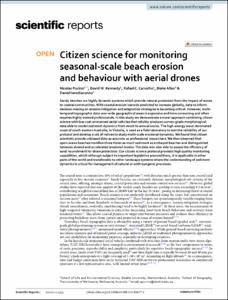| dc.contributor.author | Pucino, Nicolas | |
| dc.contributor.author | Kennedy, David M. | |
| dc.contributor.author | Carvalho, Rafael C. | |
| dc.contributor.author | Allan, Blake | |
| dc.contributor.author | Ierodiaconou, Daniel | |
| dc.date.accessioned | 2022-03-31T13:00:55Z | |
| dc.date.available | 2022-03-31T13:00:55Z | |
| dc.date.issued | 2021 | |
| dc.identifier.citation | Pucino, N., Kennedy, D.M., Carvalho, R.C. et al. (2021) Citizen science for monitoring seasonal-scale beach erosion and behaviour with aerial drones. Scientific Reports, 11:3935, 17pp. DOI: https://doi.org/10.1038/s41598-021-83477-6 | en_US |
| dc.identifier.uri | https://repository.oceanbestpractices.org/handle/11329/1901 | |
| dc.description.abstract | Sandy beaches are highly dynamic systems which provide natural protection from the impact of waves
to coastal communities. With coastal erosion hazards predicted to increase globally, data to inform
decision making on erosion mitigation and adaptation strategies is becoming critical. However, multitemporal
topographic data over wide geographical areas is expensive and time consuming and often
requires highly trained professionals. In this study we demonstrate a novel approach combining citizen
science with low-cost unmanned aerial vehicles that reliably produces survey-grade morphological
data able to model sediment dynamics from event to annual scales. The high-energy wave-dominated
coast of south-eastern Australia, in Victoria, is used as a field laboratory to test the reliability of our
protocol and develop a set of indices to study multi-scale erosional dynamics. We found that citizen
scientists provide unbiased data as accurate as professional researchers. We then observed that
open-ocean beaches mobilise three times as much sediment as embayed beaches and distinguished
between slowed and accelerated erosional modes. The data was also able to assess the efficiency of
sand nourishment for shore protection. Our citizen science protocol provides high quality monitoring
capabilities, which although subject to important legislative preconditions, it is applicable in other
parts of the world and transferable to other landscape systems where the understanding of sediment
dynamics is critical for management of natural or anthropogenic processes. | en_US |
| dc.language.iso | en | en_US |
| dc.rights | Attribution 4.0 International | * |
| dc.rights.uri | http://creativecommons.org/licenses/by/4.0/ | * |
| dc.subject.other | Drone | en_US |
| dc.subject.other | Beach erosion | en_US |
| dc.subject.other | Sand nourishment | en_US |
| dc.subject.other | Shore protection | en_US |
| dc.subject.other | Coastal erosion | en_US |
| dc.subject.other | Citizen science | |
| dc.title | Citizen science for monitoring seasonal‑scale beach erosion and behaviour with aerial drones. | en_US |
| dc.type | Journal Contribution | en_US |
| dc.description.refereed | Refereed | en_US |
| dc.format.pagerange | 17pp. | en_US |
| dc.identifier.doi | https://doi.org/10.1038/s41598-021-83477-6 | |
| dc.subject.parameterDiscipline | Sedimentation and erosion processes | en_US |
| dc.subject.dmProcesses | Data acquisition | en_US |
| dc.bibliographicCitation.title | Scientific Reports | en_US |
| dc.bibliographicCitation.volume | 11 | en_US |
| dc.bibliographicCitation.issue | Article 3935 | en_US |
| dc.description.sdg | 14.a | en_US |
| dc.description.eov | N/A | en_US |
| dc.description.adoption | Novel (no adoption outside originators) | en_US |
| dc.description.sensors | Aerial drones | en_US |
| dc.description.methodologyType | Reports with methodological relevance | en_US |
| obps.contact.contactname | Nicholas Pucino | |
| obps.contact.contactemail | npucino@deakin.edu.au | |
| obps.resourceurl.publisher | https://www.nature.com/articles/s41598-021-83477-6 | |
 Repository of community practices in Ocean Research, Applications and Data/Information Management
Repository of community practices in Ocean Research, Applications and Data/Information Management

